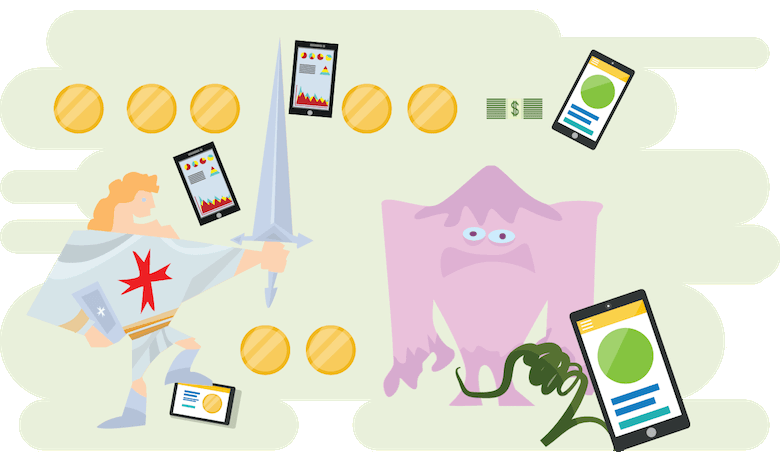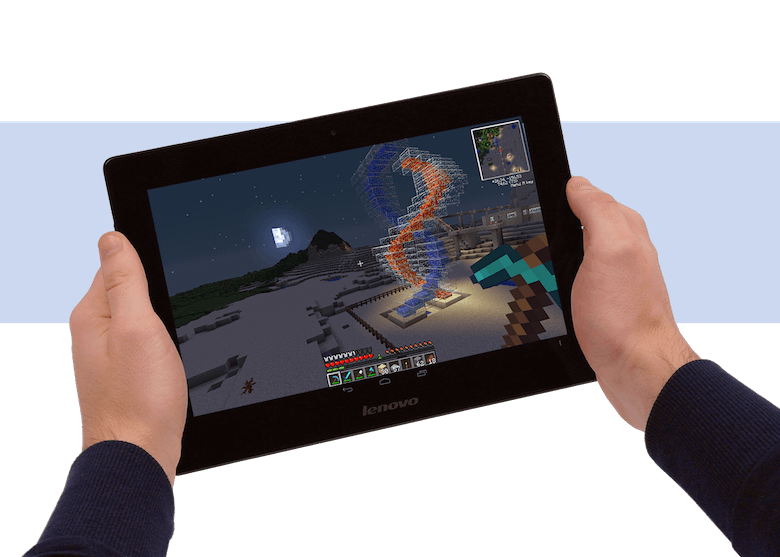Trends and prospects for the mobile application market: let's talk about money

The market for mobile apps is growing by leaps and bounds. This huge industry is expanding every day and is not going to stop. The army of developers of mobile applications has grown dramatically, breaking the number of applications themselves. Revenue generated by the mobile apps industry has reached transcendental numbers.
Hybrid monetization models (for example, embedded advertising and in-app purchases) are quickly gaining popularity in the business world. Most studies suggest that embedded advertising will be a major factor in the growth of the mobile market in the coming years .
')
We in Alconost have translated an article that sheds light on the following questions:
- What is the average revenue for a mobile app?
- Is the average income growing?
- What are the biggest challenges facing the mobile app industry today?
- What are the most popular monetization models on the market today? What will be the growth factors of tomorrow? What models have already outlived theirs?
All of the findings below are based on statistical reports and expert opinion.
Mobile apps market still has a large growth margin
According to App Annie , the mobile application industry has created a whopping $ 41.1 billion in gross annual income, which is expected to grow to $ 50.9 billion. According to Statista's forecasts , gross annual income in 2020 will exceed $ 189 billion. Despite the fact that Researchers are a little different, the general conclusion is this: the market is far from saturation. App Annie's predictions were confirmed in Forrester reports that by the end of 2016, only 46% of the world's population owned smartphones. This suggests that the widely discussed mobile revolution is just beginning.
Other Forrester statistics show a huge gap between leading companies, for which mobile devices have become the catalyst for the transformation of their business, and companies that treat mobile devices simply as another development direction. At the beginning of 2016, only 18% of surveyed companies were in the first category. This figure is expected to overcome 25% next year.
Consumers evolve even faster than business. Today, the mobile Internet has become an urgent need for many users.
As far as popularity is concerned, aggregator applications are likely to come to the fore. These are tools that allow you to get content from different online resources and combine it in a simple, clear interface. Content can be very diverse: from hot news to niche interests. Aggregators are designed for those who do not have the time or desire to visit many sites or install many applications. Popular aggregator applications include Flipboard, News360, Feedly and IFTTT.
Application aggregators, as a rule, are gaining popularity among users in cases where they are convenient or improve the shopping process. For example, Facebook did this with the Messenger app, which allows users to read their feeds and call Uber.
Rich and poor platforms
Two giants of mobile development, Android and iOS, dominate the global smartphone market. According to a Gartner study , 87.8% of smartphones sold in the third quarter of 2016 are Android’s share. This figure is 3.1% higher than a year ago. IOS market share - 11.5% (2% lower than in 2015). And although this figure is negligible for a huge market share already covered, this growth greatly weakens the positions of other market players. Windows, on whose account 0.4% of all smartphones sold, finished third in the race of mobile platforms with a 2.5% decline in its share for the year.
Apple and Google have the largest and most popular app stores. Today it seems that the rest of the market participants have nothing to dream of comparing with them in the range of applications and the number of developers.
According to InMobi , 55% of developers earn less than $ 1000. Moreover, a third of application developers worldwide have failed to achieve 10,000 downloads of their products. Income inequality is more pronounced for Android developers, while among iOS developers, income distribution is more balanced.
Since 2016, more than 25% of iOS developers have generated over $ 5,000 in monthly revenue. Among Android developers, only 16% achieved such figures.
But the interesting statistics of the average monthly income, which brought mobile operating systems. Forbes estimates that iOS earned, on average, $ 4,000 per month; Android was in second place with its $ 1,125; on the third - the outsider of Windows Phone and only $ 625.
However, this situation has changed dramatically in 2016. According to Statista , the Windows Phone application brings, on average, $ 11,400 per month, while the iOS application generates $ 8,100 , and Android - $ 4,900. At the same time, 75% of developers are followers of Android. They have plans to increase their income by making products for Android.
The range of mobile applications
High-performance mobile processors, powerful graphics support, high-quality screens and a fast Internet connection have turned smartphones into gaming devices. According to App Annie reports , mobile games, which in 2011 accounted for less than 50% of the revenue from all mobile applications, generated 85% of the revenue of the mobile application market in 2015. This is $ 34.8 billion for the whole world.
 The growing share of mobile gaming in the mobile application industry is impressive.
The growing share of mobile gaming in the mobile application industry is impressive.The time users spend in various types of applications has dramatically increased. In this case, non-game applications bypassed the game. According to Flurry Analytics , by the end of 2015, the mobile application market has set a new record for using applications:
- Applications for device personalization (shells, icons, background images for the main screen and lock screen, etc.) topped the list with a staggering 332% increase in usage per session.
- Mobile versions of newspapers and magazines ranked second with a huge increase of 135%.
- Productivity tools in third place: 125% growth.
- Solutions for shopping and lifestyle showed 81% growth and fourth place.
- Applications for travel, sports, health and fitness - along with instant messengers and social applications - grew by 53–54%.
- The games were the only outsider: users spent less by 1% of the time in them.
Monetization models
Today, there are six popular models of monetization of applications.
Direct sales
If the paid application has not yet been purchased, only screenshots, descriptions and videos are available for viewing. They are needed in order to convince people to buy the application and show that they will receive exactly what they see. But with this approach, it is difficult for users to make a decision, which probably affected the disappointing statistics: paid applications are not among the most profitable ones. It is paid applications that lose the battle for popularity, although in some cases they still justify themselves.
Minecraft Pocket Edition is the most profitable app on Google Play. Minecraft was released in 2011 as a sandbox video game, costing $ 6.99 per download.
 Minecraft pocket edition
Minecraft pocket editionFreemium: conditionally free
When using Freemium (a combination of "free", i.e. "free" and "premium"), the main features are available to users for free, and extended functionality - for a one-time fee or for a paid subscription. Usually the number of those willing to pay is relatively small. Therefore, applications using this model are focused on ensuring the maximum number of downloads.
Despite serious criticism of its potentially speculative mechanisms, the Freemium model works remarkably well with deliberate use. The best example is Clash of Clans .

Clash of clans
Subscription
Subscription is similar to Freemium. The difference is that users pay for access to the full content, not to individual features. This model generates predictable long-term revenue for the owner, maintaining high user loyalty.
A great example of a subscription application is Lumosity , in which more than 50 different exercises developed by cognitive psychologists for brain training. Lumosity offers a subscription for a month ($ 11.99 per month) and a year ($ 59.99 per year). The average rating of the application, based on estimates of 93,000 users, is five stars, and this is a phenomenal success among the applications by subscription.

Lumosity application
Built-in purchases
Monetization through built-in purchases is very typical for mobile games, as well as for various applications with product catalogs that charge for services when selling each position. This model is so flexible that some games overdo it with calls to shop. According to the Tech Times for February 2016, about 1.9% of mobile game users made purchases from apps, and the number of such players is growing steadily.
Example - MeetMe , a social application in which users can also buy some products and services. In MeetMe you can pay a certain amount to increase the number of views of your profile. Developers get a decent income due to clear sales system.

Meetme
Crowdfunding
Crowdfunding is a relatively new monetization model. The developers present the idea of the application they want to create on a popular online platform like Kickstarter or Indiegogo and ask to support the idea with contributions. It happens that interesting projects receive funding several times more than originally requested, while mediocre projects do not collect the necessary amounts.
Technical startup Shadow is a perfect example. The project achieved impressive success with crowdfunding: developers received $ 82,577 from 3,784 people who supported the project. Shadow went to the crowdfunding sleep tracking application, adding exclusivity to the awards and the project.
For owners of the exclusive Shadow card, the application was free, but even when its price rose to $ 8, it was possible to earn about $ 20,000 on this alone.

Shadow
Sponsorship
Sponsorship is a fairly new model of monetization. Users act as advertising sponsors in exchange for a fee. A portion of each payout goes to the developers. The model is still raw, its marketing strategy needs to be improved.
RunKeeper , whose community includes more than 45 million users, is a good example of a sponsorship business model. The application encourages users to overcome a certain distance by running or cycling. Then advertisers pay users. The model is based on trust in developers who place no annoying ads.

Runkeeper
Monetization through advertising
This is the most popular monetization model and needs to be considered in more detail. The reason for its popularity is obvious: users like to download free applications, and the greater the number of downloads - the greater the income of developers. The IHS Markit report suggests that by 2020, embedded advertising will generate $ 53.4 billion in total revenue per year. This is almost 63% of revenue from mobile display advertising.
As in other sectors, several mainstream application developers with advertisements generate the bulk of revenue. All other developers are forced to be content with the remains. According to Klick Health , Facebook is the undisputed leader with 44.3% of all mobile ad impressions through its apps. Next in the ranking in order: Alibaba, Google, Tencent, Twitter, Pandora and Yahoo.
Companies generating the highest advertising revenue are often the main advertising sponsors. This trend is particularly noticeable among mobile games. Major developers such as Rovio, Gameloft and Disney are recruiting hundreds of small indie studios who advertise their gaming products in less popular games.
Results
As you can see, the explosive growth of the mobile application market will continue in the near future. Despite the increasing competition in the industry, developers are applying new monetization methods and create increasingly interesting and useful solutions for users. At least two new models of monetization have proven themselves and are gaining popularity in recent days.
None of the models we have considered can be called ineffective. On the contrary: developers and publishers have learned how to apply these models according to the situation. For example, the subscription model works only in certain niches, but is the most profitable of all. At the same time, the Freemium model, which is so criticized for potential dishonesty, when used deliberately, gives amazing results, as exemplified by the Clash of Clans . And only paid applications fall out of favor, although they still justify themselves in some cases.
Hybrid monetization models, such as embedded advertising and in-app purchases, are clearly gaining popularity in the business world. Most studies suggest that embedded advertising will be a major factor in the growth of the mobile market in the coming years.
Today, iOS and Android are the leading mobile operating systems, and the tech giants Apple and Google own the largest mobile app stores.
How the mobile gaming market will evolve, time will tell. Market trends suggest that in the foreseeable future the market will continue to generate more and more income. It is clear that the widely discussed mobile application revolution is just beginning.
About the translator
The article is translated in Alconost.
Alconost is engaged in the localization of applications, games and sites in 62 languages. Language translators, linguistic testing, cloud platform with API, continuous localization, 24/7 project managers, any formats of string resources.
We also make advertising and training videos - for websites selling, image, advertising, training, teasers, expliners, trailers for Google Play and the App Store.
Read more: alconost.com
Source: https://habr.com/ru/post/323020/
All Articles